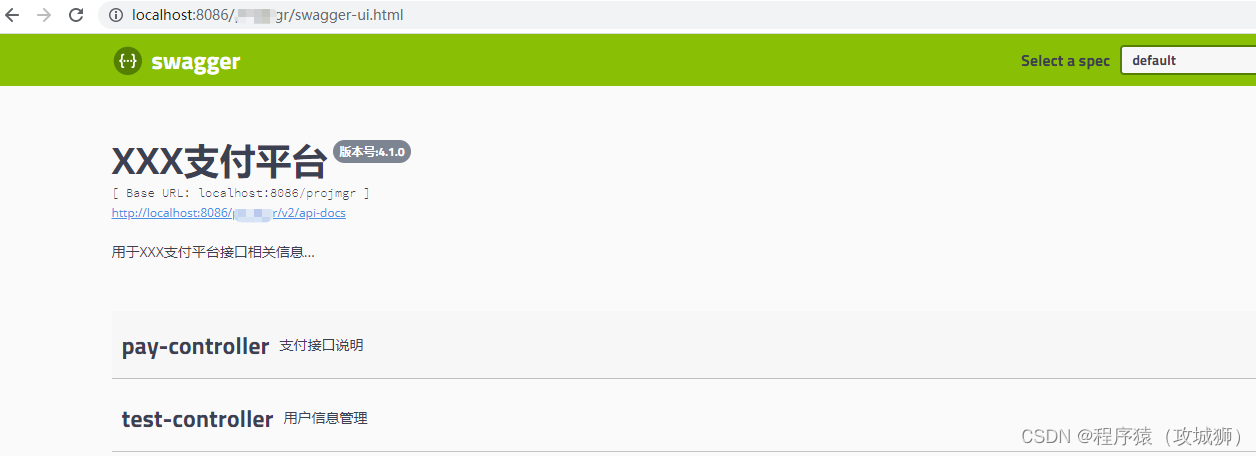对于需要提供接口给第三方访问的平台,有一个完整、准确的接口文档,是很有帮助的。由于业务增加或者变更,经常需要对接口进行更新维护,单独的接口文档维护常常不能及时保持与实际接口变更同步,导致看到的接口文档是过时和不准确。
swagger通过在接口中增加相关的注解,由swagger根据注解中的内容自动生成接口文档,在开发接口的同时,就完成了接口文档的编写,最后由swagger根据代码中的注解生成标准格式的在线接口文档。此外,还可以在线对接口进行测试。
1. 添加依赖
<!-- swagger2-->
<dependency>
<groupId>io.springfox</groupId>
<artifactId>springfox-swagger2</artifactId>
<version>2.9.2</version>
</dependency>
<dependency>
<groupId>io.swagger</groupId>
<artifactId>swagger-annotations</artifactId>
<version>1.5.21</version>
</dependency>
<dependency>
<groupId>io.swagger</groupId>
<artifactId>swagger-models</artifactId>
<version>1.5.21</version>
</dependency>
<!-- swagger2-UI-->
<dependency>
<groupId>io.springfox</groupId>
<artifactId>springfox-swagger-ui</artifactId>
<version>2.9.2</version>
</dependency>2. 添加资源拦截器
import org.springframework.context.annotation.Configuration;
import org.springframework.web.servlet.config.annotation.InterceptorRegistry;
import org.springframework.web.servlet.config.annotation.ResourceHandlerRegistry;
import org.springframework.web.servlet.config.annotation.ViewControllerRegistry;
import org.springframework.web.servlet.config.annotation.WebMvcConfigurer;
@Configuration
public class ResourcesConfig implements WebMvcConfigurer
{
@Override
public void addResourceHandlers(ResourceHandlerRegistry registry)
{
/** swagger配置 */
registry.addResourceHandler("swagger-ui.html").addResourceLocations("classpath:/META-INF/resources/");
registry.addResourceHandler("/webjars/**").addResourceLocations("classpath:/META-INF/resources/webjars/");
}
}3. 接口添加注解
import io.swagger.annotations.Api;
import io.swagger.annotations.ApiImplicitParam;
import io.swagger.annotations.ApiModel;
import io.swagger.annotations.ApiModelProperty;
import io.swagger.annotations.ApiOperation;
@Api("支付接口说明")
@RestController
@RequestMapping("/pay")
public class PayController extends BaseController
{
@ApiOperation("支付请求")
@PostMapping("/payorder")
@RepeatSubmit
public AjaxResult payorder(OrderEntity order)
{
if (StringUtils.isNull(order) || StringUtils.isNull(order.getOrderId()))
{
return error("用户ID不能为空");
}
return AjaxResult.success(1);
}
}4. 参数定义
import io.swagger.annotations.ApiModel;
import io.swagger.annotations.ApiModelProperty;
@ApiModel("订单实体")
class OrderEntity
{
@ApiModelProperty("订单ID")
private Integer orderId;
@ApiModelProperty("商户编号")
private String merchantNo;
@ApiModelProperty("订单编号")
private String orderNo;
@ApiModelProperty("商品名称")
private String productName;
public Integer getOrderId() {
return orderId;
}
public void setOrderId(Integer orderId) {
this.orderId = orderId;
}
public String getMerchantNo() {
return merchantNo;
}
public void setMerchantNo(String merchantNo) {
this.merchantNo = merchantNo;
}
public String getOrderNo() {
return orderNo;
}
public void setOrderNo(String orderNo) {
this.orderNo = orderNo;
}
public String getProductName() {
return productName;
}
public void setProductName(String productName) {
this.productName = productName;
}
}5. swagger基本配置
@Configuration
@EnableSwagger2
public class SwaggerConfig
{
/**
* 创建API
*/
@Bean
public Docket createRestApi()
{
return new Docket(DocumentationType.SWAGGER_2)
// 用来创建该API的基本信息,展示在文档的页面中(自定义展示的信息)
.apiInfo(apiInfo())
// 设置哪些接口暴露给Swagger展示
.select()
// 扫描所有有注解的api,用这种方式更灵活
.apis(RequestHandlerSelectors.withMethodAnnotation(ApiOperation.class))
// 扫描指定包中的swagger注解
//.apis(RequestHandlerSelectors.basePackage("com.ruoyi.project.tool.swagger"))
// 扫描所有 .apis(RequestHandlerSelectors.any())
.paths(PathSelectors.any())
.build();
}
/**
* 添加摘要信息
*/
private ApiInfo apiInfo()
{
// 用ApiInfoBuilder进行定制
return new ApiInfoBuilder()
// 设置标题
.title("支付平台")
// 描述
.description("用于支付平台接口相关信息..")
// 作者信息
.contact(new Contact(Global.getName(), null, null))
// 版本
.version("版本号:" + Global.getVersion())
.build();
}
}
6. 通过页面访问

?接口在线测试:

?可以看到,在接口中添加到注解的说明信息,都显示在页面上了。根据代码中的注解说明,很方便知道参数的含义。